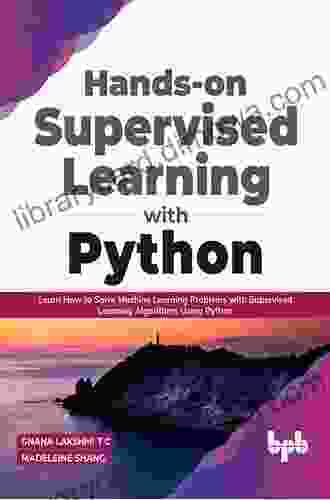Learn How To Solve Machine Learning Problems With Supervised Learning

Machine learning has become an indispensable tool for businesses and organizations seeking to harness the power of data. By leveraging machine learning algorithms, we can automate tasks, improve decision-making, and uncover hidden insights within complex datasets. Supervised learning is a fundamental branch of machine learning that enables computers to learn from labeled data, empowering them to make predictions or classifications on new, unseen data.
5 out of 5
| Language | : | English |
| File size | : | 6269 KB |
| Text-to-Speech | : | Enabled |
| Enhanced typesetting | : | Enabled |
| Print length | : | 474 pages |
| Screen Reader | : | Supported |
| Paperback | : | 45 pages |
| Item Weight | : | 4.2 ounces |
| Dimensions | : | 6 x 0.12 x 9 inches |
This comprehensive guide will delve into the world of supervised learning, providing a step-by-step approach to solving machine learning problems effectively. We will cover the entire workflow, from data preparation and model selection to evaluation and optimization, ensuring you have a solid understanding of how to apply supervised learning techniques to real-world problems.
Step 1: Data Preparation
The foundation of successful machine learning lies in data preparation. This stage involves collecting, cleaning, and transforming raw data into a format that is suitable for analysis. It includes:
- Data Collection: Gather relevant data from various sources, ensuring it is representative of the problem you aim to solve.
- Data Cleaning: Remove errors, inconsistencies, and duplicates from the data to ensure its integrity.
- Data Transformation: Convert data into a format compatible with machine learning algorithms, such as numeric values or one-hot encoding for categorical data.
- Feature Engineering: Create new features to enhance the model's performance, such as combining multiple variables or creating dummy variables.
Step 2: Model Selection
Once the data is prepared, the next step is to select an appropriate supervised learning algorithm. The choice of model depends on the problem you are trying to solve and the characteristics of the data. Common supervised learning algorithms include:
- Linear Regression: Used for predicting continuous values based on a linear relationship with input features.
- Logistic Regression: Suitable for binary classification problems where the target variable takes on values of 0 or 1.
- Support Vector Machines (SVMs): Non-linear classifiers that can handle both linear and complex data.
- Decision Trees: Tree-like structures that make predictions by splitting the data into subsets based on feature values.
- Random Forests: Ensembles of decision trees that improve accuracy and robustness.
Step 3: Training and Evaluation
With the model selected, it is time to train it on the prepared data. Training involves feeding the model with labeled data to learn the underlying patterns and relationships. Once trained, the model's performance is evaluated on a separate holdout dataset to assess its generalization ability:
- Model Training: Optimize the model's parameters to minimize the error on the training data.
- Model Evaluation: Calculate metrics such as accuracy, precision, recall, and F1-score to measure the model's performance on the holdout dataset.
- Cross-Validation: Divide the training data into multiple subsets to perform multiple rounds of training and evaluation, providing a more robust estimate of model performance.
Step 4: Optimization and Deployment
Once the model is trained and evaluated, the next step is to optimize it for deployment. This involves fine-tuning the model's hyperparameters, such as learning rate and regularization parameters, to enhance its performance further:
- Hyperparameter Tuning: Experiment with different hyperparameter values to identify the optimal combination that yields the best
5 out of 5
| Language | : | English |
| File size | : | 6269 KB |
| Text-to-Speech | : | Enabled |
| Enhanced typesetting | : | Enabled |
| Print length | : | 474 pages |
| Screen Reader | : | Supported |
| Paperback | : | 45 pages |
| Item Weight | : | 4.2 ounces |
| Dimensions | : | 6 x 0.12 x 9 inches |
Do you want to contribute by writing guest posts on this blog?
Please contact us and send us a resume of previous articles that you have written.
 Book
Book Novel
Novel Page
Page Chapter
Chapter Text
Text Story
Story Genre
Genre Reader
Reader Library
Library Paperback
Paperback E-book
E-book Magazine
Magazine Newspaper
Newspaper Paragraph
Paragraph Sentence
Sentence Bookmark
Bookmark Shelf
Shelf Glossary
Glossary Bibliography
Bibliography Foreword
Foreword Preface
Preface Synopsis
Synopsis Annotation
Annotation Footnote
Footnote Manuscript
Manuscript Scroll
Scroll Codex
Codex Tome
Tome Bestseller
Bestseller Classics
Classics Library card
Library card Narrative
Narrative Biography
Biography Autobiography
Autobiography Memoir
Memoir Reference
Reference Encyclopedia
Encyclopedia Annajo Janisz
Annajo Janisz Kjell Prytz
Kjell Prytz Clemency Montelle
Clemency Montelle James E Doyle
James E Doyle Mark Batey
Mark Batey Anika Fajardo
Anika Fajardo Bonnie Bader
Bonnie Bader Annie Cosby
Annie Cosby Sam Rudder
Sam Rudder Elizabeth Enslin
Elizabeth Enslin James Lovegrove
James Lovegrove Bob Lee
Bob Lee Annika Ziehen
Annika Ziehen Annamaria Olivieri
Annamaria Olivieri Anita Arvast
Anita Arvast Ari Bach
Ari Bach Anthony Vincent Bruno
Anthony Vincent Bruno April Henry
April Henry Aran S Mackinnon
Aran S Mackinnon Arden Bevere
Arden Bevere
Light bulbAdvertise smarter! Our strategic ad space ensures maximum exposure. Reserve your spot today!
 Kenneth ParkerFollow ·14.7k
Kenneth ParkerFollow ·14.7k Elliott CarterFollow ·7.1k
Elliott CarterFollow ·7.1k Jackson HayesFollow ·16.7k
Jackson HayesFollow ·16.7k Mitch FosterFollow ·6.8k
Mitch FosterFollow ·6.8k Howard PowellFollow ·15.9k
Howard PowellFollow ·15.9k Cormac McCarthyFollow ·11.5k
Cormac McCarthyFollow ·11.5k Robert Louis StevensonFollow ·16.6k
Robert Louis StevensonFollow ·16.6k Pete BlairFollow ·16.8k
Pete BlairFollow ·16.8k

 Anton Chekhov
Anton ChekhovMother Goose The Old Nursery Rhymes Illustrated By Arthur...
A Journey Through the Enchanted Gardens of...

 Alexander Blair
Alexander BlairUnleash the Power of Imagination: Exploring the...
A Literary...

 Harry Hayes
Harry Hayes50 Quick and Easy Ways to Become Brilliant at Project...
Project stakeholder...

 Gus Hayes
Gus HayesSimple Practical Tips To Understand The Basics Of...
: The Looming Threat of...

 Connor Mitchell
Connor MitchellUnleash Your Literary Superpowers: Immerse Yourself in...
Welcome to a Captivating Universe of...
5 out of 5
| Language | : | English |
| File size | : | 6269 KB |
| Text-to-Speech | : | Enabled |
| Enhanced typesetting | : | Enabled |
| Print length | : | 474 pages |
| Screen Reader | : | Supported |
| Paperback | : | 45 pages |
| Item Weight | : | 4.2 ounces |
| Dimensions | : | 6 x 0.12 x 9 inches |














